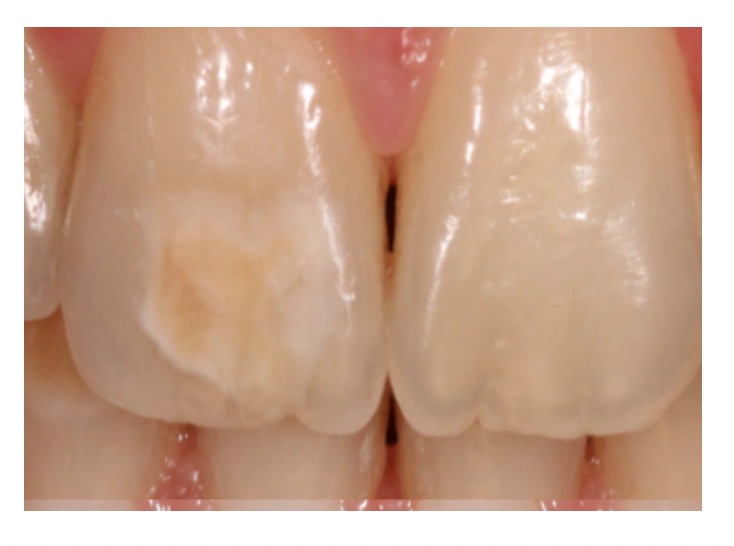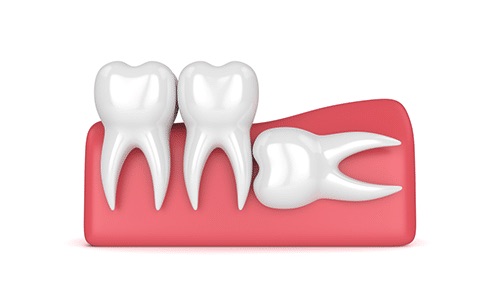Common Procedures
Pediatric Dental Procedures in Winston-Salem and Kernersville, NC
Topics on this page

Regular Exams and Cleanings
What is completed during my child's exam and cleaning visit?
Regular exams are an important part of maintaining your child's oral health. During your child’s regular exam, we will:
- Answer any questions and address any concerns
- Assess growth and development
- Look for cavities or any other signs of tooth decay
- Inspect the teeth and gums for gingivitis and signs of periodontal disease
- Check for any problems that may not be seen or felt
- Perform a thorough teeth cleaning
- Discuss an individiualize prevention plan for your child
How long will a dental exam and cleaning visit take?
Your child’s exam will take about 30-45 minutes. Each regular exam includes a detailed teeth cleaning, in which we will clean, polish, and rinse the teeth to remove any tartar and plaque that have built up on the tooth’s surface. Fluoride may be applied to the teeth to make them stronger and more resistant to tooth decay. We utilize the most effective fluoride available which is in varnish form. You will be instructed to not brush the night of your fluroide application.
How often should I have my child's teeth cleaned?
Visiting our office every six months has been shown to be an effective way to prevent dental disease and enables your family to ask any questions about your child’s oral health. Regular exams are offered by appointment only, so please contact our practice today to schedule your child’s next dental exam and teeth cleaning.
Crowns
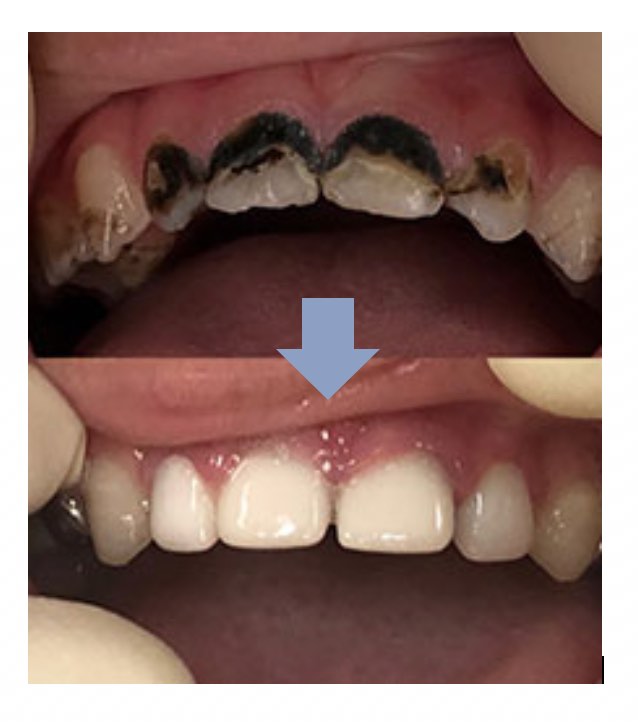
Why could my child need a dental crown?
Crowns are a restorative procedure used to improve a tooth’s shape or to strengthen a tooth. Crowns are most often used for teeth that are broken, worn, or have portions destroyed by tooth decay where there is little remaining healthy tooth structure. Crowns can also be used on the front teeth to replace areas of fracture or decay.
How do dental crowns work?
A crown is a “cap” cemented onto an existing tooth that usually covers the portion of the tooth above the gumline. In effect, the crown becomes the tooth’s new outer surface.
What are dental crowns made of?
Crowns can be made of porcelain (tooth-colored) or metal (stainless steel). Porcelain crowns are often preferred in the front because they mimic the translucency of natural teeth and are very strong. On the back teeth, either zirconia or stainless steel crowns may be recommended depending on the extent and position of tooth decay.
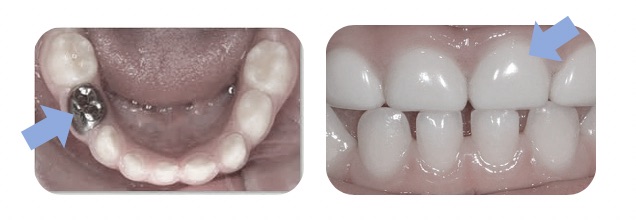
How should I take care of my child after his/her dental crowns are placed?
Click the link here for our 'after visit care instructions' for silver and white dental crowns.
Extractions
Occasionally, it is necessary to remove a tooth. Sometimes a baby tooth has misshapen or long roots that prevent it from falling out as it should, and the tooth must be removed to make way for the permanent tooth to erupt. Infection, extensive dental decay, orthodontic correction, or problems with a wisdom tooth can also be indications for the doctor to recommend tooth extractions. If one of your child's teeth are recommended to be removed, we will discuss different options to keep him or her as comfortable as possible. We will also discuss in detail post-operative care with you prior to the appointment.
How should I take care of my child after he/she has a tooth extracted
Click the link here for our 'after visit care instructions' for tooth removal.
Enamel Hypoplasia Treatment
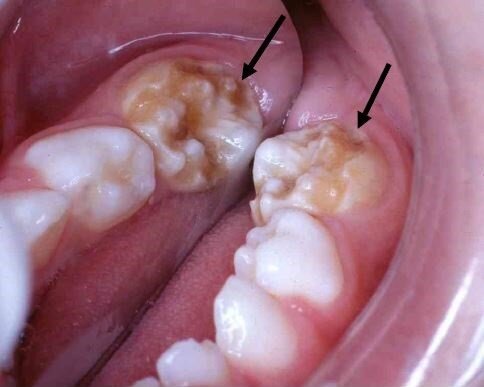
What is enamel hypoplasia?
The outer layer of the tooth, the enamel, should be slightly translucent. Enamel hypoplasia, or enamel hypomineralization, is a defect area in the outer layer where the tooth will appear more opaque, cloudy and either white, yellow, or brown in color. The condition is formed while the teeth are developing and can be found on both baby teeth and permanent teeth.
Does better brushing improve enamel hypoplasia?
Because enamel hypoplasia is a developmental defect, the cause is independent of your children's ability to brush and floss. However, excellent brushing and flossing can help to prevent future complications.
Why is the significance of enamel hypoplasia?
In areas of enamel hypoplasia, the enamel is thinner and more brittle. As a result, the tooth is more prone to hot/cold sensitivity, chipping, and cavities. Teeth with enamel hypoplasia must be monitored closely by the dentist to ensure they are staying healthy and often require dental treatment.
How can enamel hypoplasia be treated?
Treatment options for teeth with enamel hypoplasia vary significantly depending on the extent of the enamel defect and whether the tooth is symptomatic. For mild enamel hypoplasia, treatment options may include monitoring the area for future changes, prescription toothpastes, or placing a dental sealant over the tooth. For moderate to severe enamel hypoplasia, treatment options may include a dental filling to replacing the defective tooth structure. At your child's visit, the dentist will evaluate and determine the best option for your child's tooth.
Fluoride

What is a dental fluoride treatment?
Fluoride is effective in preventing cavities and tooth decay and in preventing plaque from building up and hardening on the tooth’s surface. A fluoride treatment in our office takes just a few minutes and is a safe way to apply the fluoride mineral to the areas which will benefit most. After the treatment, your child may be asked not to eat anything sticky or drink anything hot for the rest of the day in order to allow the teeth to absorb the fluoride. Depending on your child’s oral health or the doctor’s recommendation, a fluoride treatment may be required every three, six, or 12 months.
Will my child need to wait to eat or drink after fluoride is placed?
Your child can eat and drink immediately after fluoride varnish is placed on his/her teeth. We ask that your child not brush their teeth the evening the fluoride is placed so it may continue to soak into the teeth overnight. We also ask that your child avoid the following items:
- Crunchy foods (apples, carrots, tortilla chips)
- Sticky foods (chewing gum, gummies)
- Hot liquids (coffee, tea, hot cocoa)
For detailed instructions on how to care for your child after fluoride varnish is placed, click here.
Mouthguards

Protecting your child’s smile while playing sports is essential. Sports-related injuries to the mouth and jaw are some of the most common injuries among children.
When should my child wear a mouthguard?
Mouthguards help protect teeth and gums from injury. If your child participates in baseball, basketball, boxing, hockey, football, gymnastics, lacrosse, martial arts, racquetball, rugby, track and field, skateboarding, skiing, snowboarding, skydiving, soccer, surfing, volleyball, water polo, weightlifting, or wrestling, then it is recommended by the American Dental Association that a mouthguard is worn.
Types of Mouthguards
Choosing the right mouthguard is essential. There are three basic types of mouthguards: the pre-made mouthguard, the “boil-and-bite” fitted mouthguard, and the custom-made mouthguard. When choosing a mouthguard, be sure to pick one that is tear-resistant, comfortable, well-fitted, easy to keep clean, and does not prevent him or her from breathing properly. If your child wears braces or a retainer, then mouthguard wear is imperative. Your dentist can help with selecting the most approrpiate mouthguard for your child, show your child how to wear a mouthguard properly and how to acheive the best fit.
Taking Care of Your Child’s Mouthguard
Similar to a retainer, braces, or any special dental appliance, it is important to take care of your child’s mouthguard by storing it properly and keeping it clean. Here are a few simple ways to keep your child’s mouthguard clean and working correctly:
- Gently scrub the mouthguard after each use with a toothbrush and toothpaste.
- Store the mouthguard in a protective case.
- Do not leave the mouthguard in the sun or in hot water, as it may melt or become deformed.
- Replace the mouthguard at the beginning of every new sports season. You should also replace your child’s mouthguard if you notice it has become worn and no longer fits properly.
- Do not wear a retainer with a mouthguard. If your child wears braces, your dentist will help design a mouthguard to protect his teeth and his braces.
- Do not chew on or cut pieces off your mouthguard.
- Bring the mouthguard to each dental checkup so your child’s dentist can check to make sure it’s still in good shape!
Our goal is to help minimize your child’s chances of a sports related injury to his smile. Be sure to ask your dentist about mouthguards at your child’s next dental checkup.
Nightguards
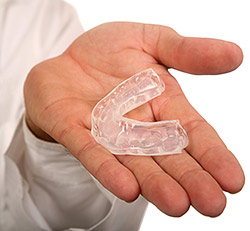
What is dental bruxism?
If your child often wakes up with jaw pain, earaches, or headaches, or if you see your child clenching or grinding his or her teeth, your child may have a condition called “bruxism”. Many people do not even know that they grind their teeth, as it often occurs when one is sleeping. If not corrected, bruxism can lead to broken teeth, cracked teeth, or even tooth loss.
Why could my child benefit from a nightguard?
There is an easy, non-invasive treatment for bruxism: nightguards. Nightguards are an easy way to prevent the wear and damage that teeth-grinding causes over time. Custom-made by a dentist from soft material to fit the teeth, a nightguard is inserted over your child’s top or bottom arch and prevents contact with the opposing teeth.
Sealants
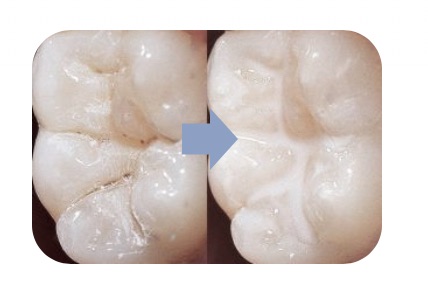
What is the benefit of dental sealants?
Sometimes brushing is not enough, especially when it comes to those hard-to-reach spots in your child’s mouth. It is difficult for a toothbrush to get in between the small cracks and grooves on the biting surfaces of your child’s teeth. If left alone, those tiny areas can develop tooth decay. Sealants give your child’s teeth extra protection against decay and can help reduce the risk of cavities on the chewing surfaces of the tooth by up to 60%.
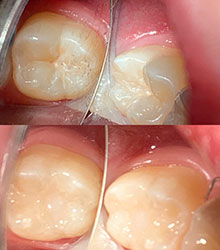 How do dental sealants prevent cavities?
How do dental sealants prevent cavities?
Dental sealants bond and harden in the deep grooves on your child’s tooth’s surface. When a tooth is sealed, the tiny grooves become smooth and are less likely to harbor plaque. With sealants, brushing your child's teeth becomes easier and more effective against tooth decay.
When are dental sealants recommended?
Sealants are typically applied to children’s teeth as a preventive measure against tooth decay after the permanent teeth have erupted. It is more common to seal “permanent” teeth rather than “baby” teeth, but every patient has unique needs, and your child’s dentist will recommend sealants on a case-by-case basis.
Tooth Colored Fillings
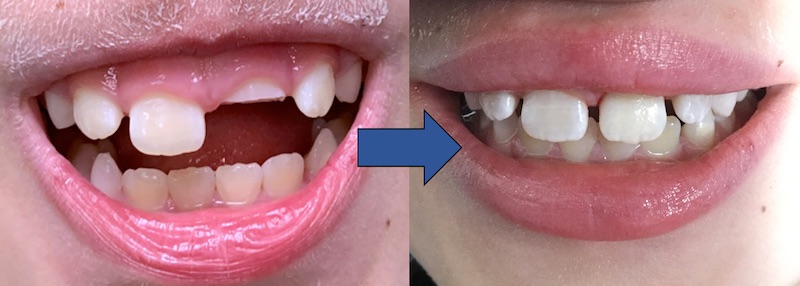
Other names for tooth colored fillings
- Dental bonding
- Restorations
- Composites
What is a tooth colored dental filling?
Bonding is a conservative way to repair chipped, discolored, or decayed teeth. During dental bonding, a white filling is placed onto your child's tooth to improve its appearance, replace areas of decay, or protect enamel defects. The filling “bonds” with the tooth, and because it comes in a variety of tooth-colored shades, it closely matches the appearance of your child's natural teeth. Many patients prefer bonded fillings because the shade of the restorative material is matched as closely as posible to the color of the natural tooth. Bonding fillings can be used on front or back teeth.
What should my child do to maintain their dental filling?
Once your dental bonding is placed, it is important to keep the area clean as food and plaque will tend to build up where the bonding meets the natural tooth structure. Excellent oral hygiene, such as good brushing and flossing, will help keep your bonding beautiful and help to prevent future staining or cavity formation beneath the tooth-colored filling.
What is recurrent decay?
Often fillings are placed when dental decay is present. If your child had a filling, though the cavity is now gone, a new one could form beneath the tooth. This is called recurrent decay. The best way to prevent recurrent decay is to keep the filling clean with brushing and flossing, just as you would take care of your natural tooth structure.
Baby tooth fillings at our office
We primarily use a special material for baby tooth fillings that is called resin-modified glass ionomer (RMGI). This material is unique in that it continually releases fluoride into the tooth and has very low rates of recurrent decay. This means once we repair a baby tooth with a filling, we are confident that the area will not get a cavity beneath it.
Wear of baby tooth RMGI restorations over time
Though resin-modified glass ionomer restorations do not get reuccrent decay, they do wear with time. Over several years, your child's RMGI restoration may appear "washed out" or "worn away". This is completely normal and will not cause any problems before your child's baby tooth falls out.
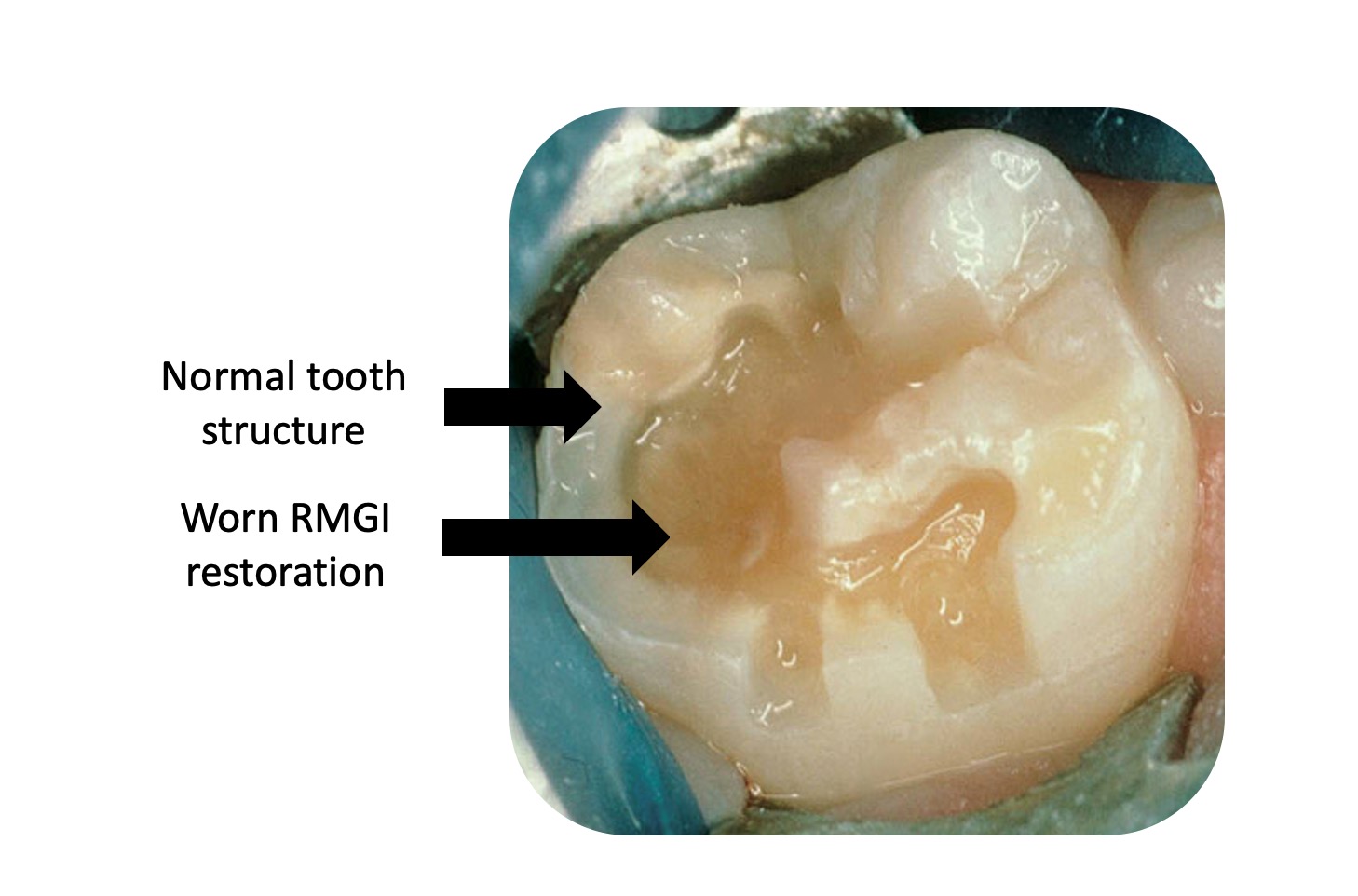
How should I take care of my child after he/she has dental fillings?
Click the link here for our 'after visit care instructions' for tooth colored dental fillings.
White Spot Lesion Treatment
What are white spot lesions?
The outer layer of the tooth, also known as the enamel, is typically partially translucent. White spot lesionsare cloudy or opaque discolorations in enamel. Typically, these lesions are white, but they can also be yellow, orange, or brown.
What causes white spot lesions?
White spot lesions can be congenital, or present from when the tooth came in. They can also be caused by trauma or poor oral hygiene. Adolescents in braces will commonly notice white spots forming if they are unable to adequately brush around their orthodontic brackets.
Can my child's white spot lesions be treated so they're less noticeable?
Most white spot lesions will fade with time, though it may take years for the areas to become less noticeable. For patients who wish to treat their white spot lesions, there are several treatment options such as MI paste, whitening, or ICON treatment to help them fade.
MI Paste
MI Paste contains calcium and phosphate and helps to heal white spot lesions. MI paste can be applied to custom dental trays and worn overnight to help remineralize the teeth.
Dental Whitening
Dental whitening, also known as bleaching, can also help fade the apperance of white spot lesions. If your child's white spot lesions were caused by poor oral hygiene or braces, it is important to wait until your dentist says it is safe to attempt whitening (usually several months after hygiene has improved). For more information on whitening, please see below.
ICON Treatment
ICON is a simple procedure to fade white spot lesions. During treatment, a gel is gently applied to the tooth for several minutes and then rinsed away. This process is repeated until the desired results are achieved. The procedure does not require numbing and typically takes ~45 minutes. The results are seen immediately.
![]()
![]()
Whitening or Dental Bleaching
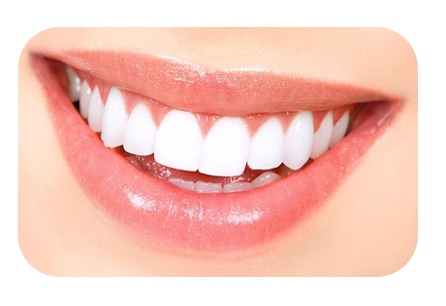
There are multiple treatment options available to brighten your smile, such as whitening toothpaste, over-the-counter whitening strips, and professional whitening trays. At our office, we recommend either premade whitening trays, such as Opalescence Go, or custom whitening trays.
What should I do if my child is interested in whiter teeth?
If your child is interested in whiter teeth, mention it at your next dental visit! If your child still has baby teeth, or is in braces, we recommend whitening toothpastes and avoiding certain foods and drinks that stain teeth. If your child has all their permanent teeth, we will discuss different bleaching options including Opalescence Go or custom whitening trays and choose the best option for you.
What if whitening makes my child's teeth sensitive?
The most common complication following dental bleaching is hypersensitivity, meaning that the teeth become more sensitive to hot and cold. This condition is termporary, and whitening can be continued with the following strategies:
- Reduce the amount of time your child whitens
- Ex: Instead of whitening for 40 minutes, try 20
- Reduce the frequencey that your child whitens
- Ex: Instead of whitening every day for 5 days, try every-other day for 10 days
- Use a sensitivity toothpaste
- Ex: Sensodyne, Colgate sensitive, or any toothpatse with potassium nitrate.
Wisdom Teeth
Does my child need his or her wisdom teeth removed?
For some, removal is not needed. Though some lucky people are missing thier wisdom teeth, most people have 4 that begin erupting (coming int othe mouth) around age 17. Occasionally, patients will have enough room to let their wisdom teeth come in without complications.
For most, removal is the best option. Most people would benefit from the removal of their wisdom teeth to prevent future complications. These complications can include pain, swelling, cavities, and gum disease. If your child is a candidate for wisdom teeth removal, one of our doctors will discuss treatment options with you.


